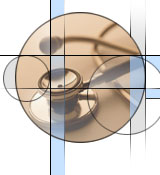






A disc usually slips to one side of the nerves or the other, however if the disc slips straight back into the middle it can press on the spinal cord and cause pain in both legs at the same time, problems with the bladder, bowels and sexual function. If any of these symptoms occur the patient need to be seen as an emergency, so as to preserve bladder and bowel function.
Investigations a MRI scan of the back will show the discs and nerves
this MRI scan shows a large prolapsed disc pressing on the S1 nerve root.
Treatment of Sciatica
Initially it is reasonable to try simple pain killers such as paracetamol or brufen, maintaining an good posture and ensuring one's weight is acceptable. These measures may relieve symptoms over the course of a few weeks.
If symptoms continue or progress a neurosurgical opinion should be sought, with an MRI after examination. A large disc pressing on the nerve root may need removing surgically if the symptoms are persistant.
Medical studies have shown that 75-80% of patients are free of leg pain after surgery, and 65-70% remain pain free after 5 years. Tingling may also improve, it is however unusual for numbness or weakness to resolve.
PATIENTS WITH PAIN IN BOTH LEGS OR CHANGE IN BLADDER, BOWEL OR ERECTILE FUNCTION MUST SEEK AN URGENT NEUROSURGICAL OPINION. ALMOST ALL PATIENTS NEED URGENT SURGERY.
Complications of surgery for sciatica
1% suffer a wound infection, 5-10% of patients may have a recurrence of symptoms, the rare risks include a csf leak, meningitis, damage to the spinal cord or nerve roots, leaving a patient weak, paralysed or incontinent.
